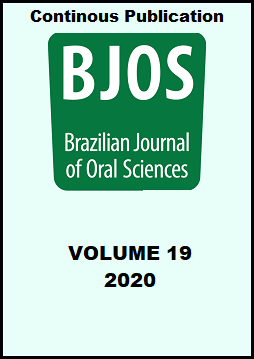Abstract
Aim: The aim of this study was to evaluate the influence of the translucency of ceramic on water sorption and solubility of resin cements over time. Methods: Lithium disilicate ceramic slides (15x15x1 mm), A1 in color and with different translucencies (high-medium-low) were manufactured; and a glass slide with similar dimension was used as control. Under every slide, 15 specimens (8x0.5 mm) from each resin cement were prepared: light-cured (RelyX Veneer); conventional dual-cured (RelyX ARC); and self-adhesive dual-cured (Rely-X U200). The specimens were then sub-divided according to the period of evaluation (immediately, after 6 and 12 months of storage) (n=5). To evaluate the loss or gain of mass, the specimens were dried until a constant mass was reached. Subsequently, they were divided according to the respective period of storage at 37°C in distilled water and weighed immediately following removal from water. After each period, specimens underwent a new dehydration. Values from water sorption and solubility were calculated and statistically analyzed (Anova 3-way/Tukey test). Results: The lower translucency resulted in greater water sorption and solubility for all cements, regardless of the experimental period. The self-adhesive dual-cured cement showed higher water sorption under all experimental periods and had worse values after 1 year aging. Differences among solubility could only be detected after aging, and the light-cured material had higher values after 6 and 12 months. Conclusions: It could be concluded that the low degree of translucency can negatively influence the passage of light and interfere on the durability of the resin cement. The conventional dual-cured resinous agent seemed to be less affected by such condition.
References
2.Uctasli S, Hasanreisoglu U, Wilson HJ. The attenuation of radiation by porcelain and its effect on polymerization of resin cements J Oral Rehabil. 1994 Sep;21(5):565-75.
3.Ilie N, Hickel R. Correlation between ceramics translucency and polymerization efficiency through ceramics. Dent Mater. 2008 Jul;24(7):908-14.
4.Cantoro A, Goracci C, Carvalho CA, Coniglio I, Ferrari M. Bonding potential of self-adhesive luting agents used at different temperatures to lute composite onlays. J Dent. 2009 Jun;37(6):454-61. doi: 10.1016/j.jdent.2009.02.006.
5.Braga RR, Cesar PF, Gonzaga CC. Mechanical properties of resin cements with different activation modes. J Oral Rehabil. 2002 Mar;29(3):257-62.
6.Souza-Junior EJ, Prieto LT, Soares GP, Dias CTS, Aguiar FHB, Paulillo LAMS. The effect of curing light and chemical catalyst on the degree of conversion of two dual cured resin luting cements. Lasers Med Sci. 2012 Jan;27(1):145-51. doi: 10.1007/s10103-010-0857-y.
7. ISO. International Standard. ISO 4049. Dentistry-Polymer-Based filling, restorative and luting materials. Geneva International Organization for Standardization; 2000. p. 18-21.
8. Runnacles P, Correr GM, Baratto Filho F, Gonzaga CC, Furuse AY. Degree of conversion of a resin cement light-cured through ceramic veneers of different thicknesses and types. Braz Dent J. 2014 Jan-Feb;25(1):38-42.
9.Soares CJ, Silva NR, Fonseca RB. Influence of the feldspathic ceramic thickness and shade on the microhardness of dual resin cement. Oper Dent. 2006 May-Jun;31(3):384-9.
10.Rasetto FH, Driscoll CF, Von Fraunhofer JA. Effect of light source and time on the polymerization of resin cement through ceramic veneers. J Prosthodont. 2001 Sep;10(3):133-9.
11.Gerdolle DA, Mortier E, Jacquot B, Panighi MM. Water sorption and water solubility of current luting cements: An in vitro study. Quintessence Int. 2008 Mar;39(3):e107-14.
12.Mese A, Burrow MF, Tyas M. Sorption and solubility of luting cements in different solutions Dent Mater J. 2008 Sep;27(5):702-9.
13.Reis AF, Giannini M, Pereira PNR. Influence of water-storage time on the sorption and solubility behavior of current adhesives and primer/adhesive mixtures. Oper Dent. 2007 Jan-Feb;32(1):53-9.
14. Aguiar TR,Andre CB, Ambrosano GMB, Giannini M. The Effect of Light Exposure on Water Sorption and Solubility of Self-Adhesive Resin Cements. Int Sch Res Notices. 2014 Oct 29;2014:610452. doi: 10.1155/2014/610452.
15. Alshali RU, Salim NA, Satterthwaite JD, Silikas N. Long-term sorption and solubility of bulk-fill and conventional resin-composites in water and artificial saliva. J Dent. 2015 Dec;43(12):1511-8. doi: 10.1016/j.jdent.2015.10.001.
16. Fabre HSC, Fabre S, Cefaly DFG, Carrilho MRO, Garcia FCP, Wanga L. Water sorption and solubility of dentin bonding agents light-cured with different light sources. J Dent. 2007 Mar;35(3):253-8.
17. Wei Y, Silikas N, Zhang Z, Watts DC. Diffusion and concurrent solubility of self-adhering and new resin–matrix composites during water sorption/desorption cycles. Dental Materials. 2011; 27 197–205.
18. Faria-e-Silva AL, Pfeifer CS. Effectiveness of high-power LEDs to polymerize resin cements through ceramics: An in vitro study. J Prosthet Dent. 2017 Nov;118(5):631-636. doi: 10.1016/j.prosdent.2016.12.013.
19. Martins FV, Vasques WF, Fonseca EM. How the Variations of the Thickness in Ceramic Restorations of Lithium Disilicate and the Use of Different Photopolymerizers Influence the Degree of Conversion of the Resin Cements: A Systematic Review and Meta-Analysis. J Prosthodont. 2019 Jan;28(1):e395-e403. doi: 10.1111/jopr.12920.
20. Müller JA, Rohr N, Fischer J. Evaluation of ISO 4049: water sorption and water solubility of resin cements. Eur J Oral Sci. 2017 Apr;125(2):141-150. doi: 10.1111/eos.12339.
21. Chaves LP, Graciano FMO, Bim Junior O, Pedreira APRV, Manso AP, Wang L. Water interaction with dental luting cements by means of sorption and solubility. Brazilian Dental Science. 2013 Mar;15(4):29-35. doi: 10.14295/bds.2012.v15i4.826.
22. Jung H, Friedl KH , Hiller KA, Furch H, Bernhart S, Schmalz G. Polymerization efficiency of different photocuring units through ceramic discs. Oper Dent. 2006 Jan-Feb;31(1):68-77.
23. Leal CV, Queiroz APV, Foxton RM, Argolo S, Mathias P, Cavalcanti AN. Water Sorption and Solubility of Luting Agents Used Under Ceramic Laminates With Different Degrees of Translucency. Oper Dent. 2016 Sep-Oct;41(5):E141-8.
The Brazilian Journal of Oral Sciences uses the Creative Commons license (CC), thus preserving the integrity of the articles in an open access environment.


